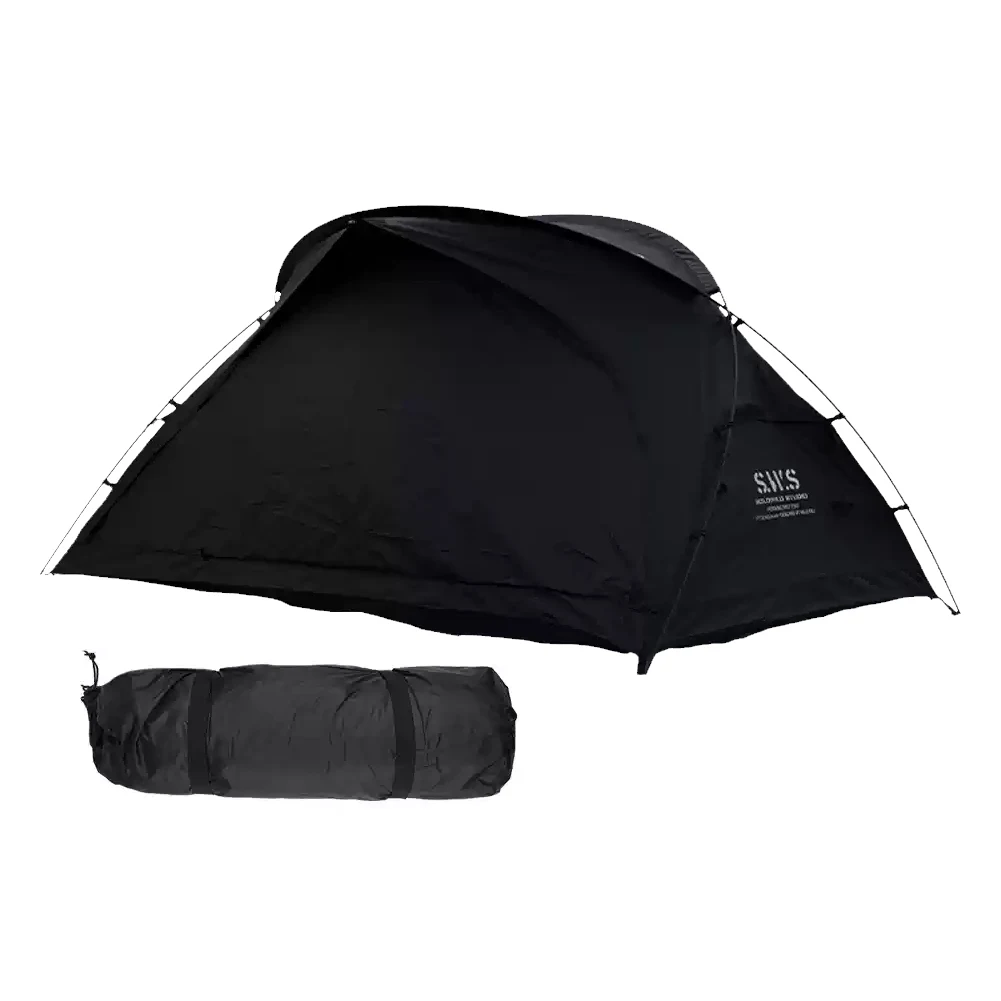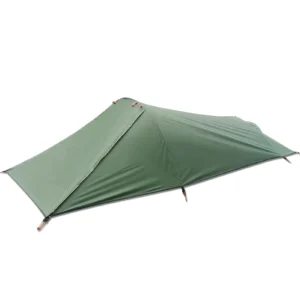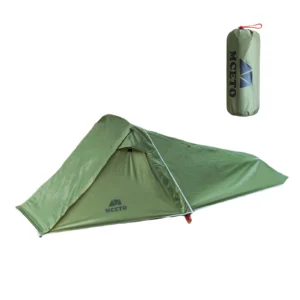1. Introduction: Why Trekking Pole Tents Are Revolutionizing Backpacking
Imagine shaving nearly a pound off your backpack weight without sacrificing shelter protection. That’s the game-changing promise of trekking pole tents – innovative shelters that use your hiking poles for structural support instead of carrying separate, dedicated tent poles. These clever designs have surged in popularity among serious backpackers, thru-hikers, and weight-conscious adventurers looking to maximize efficiency on the trail.
The concept is brilliantly simple: rather than lugging around specialized tent poles that serve only one purpose, trekking pole tents leverage gear you’re already carrying. This multi-use approach typically saves 8-16 oz (227-454g) compared to traditional tent designs – weight savings that your shoulders, knees, and feet will appreciate after long days on the trail.
Beyond just weight reduction, these shelters offer remarkable packability, often compressing down to the size of a water bottle. This compact profile leaves more room in your pack for food, water, and other essentials. The versatility of these designs also allows for creative setups adapted to various terrain and weather conditions.
At Explore Elements, we’ve field-tested dozens of trekking pole shelters across diverse environments – from rainy Pacific Northwest forests to windy alpine ridges. Our assessment considers weather performance, durability, livability, and setup complexity to provide you with trustworthy recommendations based on real-world experience.
In this comprehensive guide, we’ll explore the full spectrum of trekking pole tent designs, analyze material considerations, offer setup tips from seasoned users, and help you determine if this innovative shelter style aligns with your outdoor adventures. Whether you’re a curious beginner or an experienced backpacker looking to lighten your load, you’ll find valuable insights for making an informed decision about compact shelters for two campers or solo adventures.
2. The Weight-Saving Advantage: How Much Lighter Are Trekking Pole Tents?
The primary appeal of trekking pole tents lies in their remarkable weight efficiency. By eliminating dedicated tent poles – which can account for 20-30% of a traditional tent’s weight – these shelters significantly lighten your load. This weight reduction comes from replacing aluminum or carbon fiber tent poles with trekking poles you’d already be carrying for hiking support.
This clever design philosophy translates to substantial real-world weight savings that directly impact your hiking comfort and endurance. When every ounce counts – particularly on long-distance treks where you might be carrying your pack for weeks or months – these weight reductions can dramatically decrease fatigue and increase enjoyment on the trail.
The weight advantages become even more apparent when comparing specific shelter types:
| Shelter Type | Traditional Tent Weight | Trekking Pole Tent Weight | Weight Savings |
|---|---|---|---|
| 1-Person Tent | 2.5-3.5 lbs (1135-1588g) | 1.2-1.8 lbs (544-816g) | 1.3-1.7 lbs (590-771g) |
| 2-Person Tent | 3.5-5.0 lbs (1588-2268g) | 1.8-2.5 lbs (816-1134g) | 1.7-2.5 lbs (771-1134g) |
| 3-Person Tent | 5.0-7.0 lbs (2268-3175g) | 2.5-3.5 lbs (1134-1588g) | 2.5-3.5 lbs (1134-1588g) |
The impact on your total base weight can be substantial. For ultralight backpackers aiming to keep their base weight under 10 pounds, switching to a trekking pole shelter might represent a 10-15% reduction in total carried weight. Even for traditional backpackers, this change can mean carrying several pounds less over the course of many miles, significantly reducing why tent weight matters on long treks.
These weight savings don’t necessarily come at the cost of protection or durability. Many lightweight tent designs for trekking now use advanced materials and clever engineering to maintain weather resistance and longevity while drastically reducing weight.
3. Understanding the Core Trekking Pole Tent Designs
Before selecting a trekking pole tent, it’s essential to understand the major design categories and their unique characteristics. Each style offers different advantages for specific conditions and preferences. The core designs vary in their structure, stability, interior space, and optimal use scenarios. Understanding how trekking pole tents work will help you make an informed decision based on your specific needs and hiking style.
3.1 Pyramid/Mid-Style Shelters
Pyramid or “mid” shelters represent one of the most stable and storm-worthy trekking pole tent designs. These shelters derive their name from their distinctive pyramid-like shape, typically using one central pole (or sometimes two) to create a steep-sided structure that excels in shedding wind, rain, and snow.
• Simple, strong design with excellent stability in harsh conditions
• Superior weather resistance with steep walls that shed precipitation effectively
• Surprisingly spacious interior with good headroom at center
• Excellent snow-shedding capability for winter camping
• Requires larger footprint and careful site selection
• Can experience condensation issues without proper ventilation tactics
Most pyramid shelters weigh between 1.2-2.2 lbs (544-998g) for two-person models, making them slightly heavier than some ultralight options but still dramatically lighter than conventional tents. Their simplicity and strength make them popular choices for all-season backpacking where weather protection is paramount.
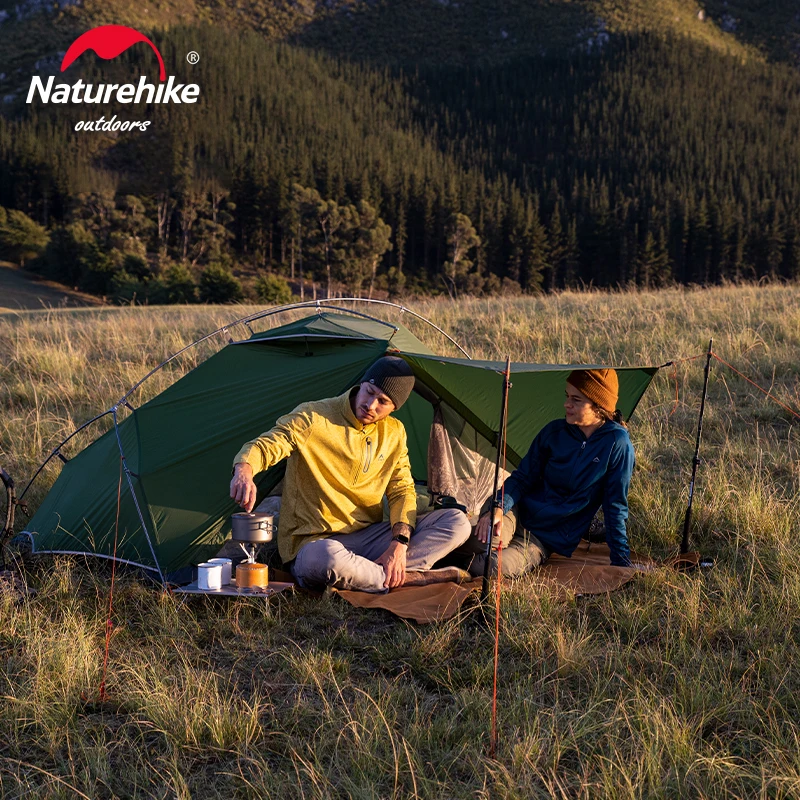
Browse our selection of trekking pole backpacking tents to compare pyramid shelter options.
3.2 A-Frame Tarp Tents
A-Frame tarp tents represent one of the oldest and most recognizable shelter designs, modernized with lightweight materials and refined features. These shelters typically use two trekking poles positioned at either end to create a ridge-line, resulting in the classic triangular profile that has protected outdoor enthusiasts for generations.
• Traditional design with proven weather protection when properly pitched
• Excellent ventilation options with adjustable doors/walls
• Good headroom along the center ridgeline
• Often modular with removable inner mesh for versatility
• Requires proper tensioning and multiple stake points
• Less stability in strong crosswinds than pyramids
A-frame designs typically weigh 1.3-2.0 lbs (590-907g) for solo models and offer excellent versatility across three-season conditions. They excel in wooded areas where wind exposure is limited and proper staking is possible.
3.3 Catenary Cut Tarp Shelters
Catenary cut tarps represent the minimalist end of the trekking pole tent spectrum, offering the absolute lightest option for experienced backpackers. These shelters feature mathematically calculated curved edges that create natural tension when pitched, resulting in a taut setup with minimal poles.
• Ultralight design, often under 1 lb (454g) for solo shelters
• Extremely packable, sometimes compressing to the size of a softball
• Adaptable to various setups and configurations
• Curved edges provide better wind stability than flat tarps
• Limited protection from insects without add-on mesh
• Requires experience and skill to pitch effectively
• Less protection in severe weather conditions
These shelters appeal to ultralight enthusiasts, experienced backpackers, and those hiking in fair weather conditions or who prioritize weight savings above all else. Our ultralight trekking pole tent collection includes several catenary cut options.
3.4 Single-Wall vs. Double-Wall Designs
The distinction between single-wall and double-wall construction represents another important consideration when selecting a trekking pole tent.
• Single-wall designs: Lighter and more packable with one layer of waterproof fabric
• Double-wall designs: Separate inner tent (typically mesh) and outer rainfly
• Condensation management: Double-walls handle moisture better through separation layers
• Weight trade-off: Single-walls save 8-16 oz (227-454g) but require more ventilation attention
• Setup complexity: Single-walls typically offer simpler, faster setup
Double-wall designs excel in humid environments or extended wet conditions, while single-wall options provide weight savings ideal for drier climates or shorter trips. The choice ultimately depends on your typical camping conditions and personal comfort preferences.
4. Critical Materials: What Makes a Quality Trekking Pole Tent
In ultralight tent design, materials play a crucial role in determining weight, durability, weather resistance, and cost. When every gram matters, the fabrics and components used become especially important. Understanding these materials helps you make informed decisions about the durability-to-weight trade-offs inherent in lightweight shelters.
4.1 Fabric Choices: DCF vs. Silnylon vs. Silpoly
The primary fabrics used in modern trekking pole tents each offer distinct advantages and limitations, significantly affecting performance and price.
Dyneema Composite Fabric (DCF, formerly called Cuben Fiber) represents the premium option in ultralight tent materials. This non-woven composite of Dyneema fibers laminated between polyester films offers an incredible strength-to-weight ratio. DCF doesn’t absorb water, won’t sag when wet, and provides exceptional waterproofing without additional treatments. However, this performance comes at a premium price – often doubling the cost of a comparable silnylon tent – and DCF has poorer abrasion resistance and UV durability than other options.
Silnylon (silicone-impregnated nylon) has long been the standard material for lightweight tents. It offers a good balance of weight, strength, and affordability. The silicone impregnation provides excellent water resistance and durability. Its main drawback is stretching when wet, which can cause sagging that requires readjustment during rainy conditions. Silnylon typically offers better tear strength than polyester alternatives.
Silpoly (silicone-impregnated polyester) has gained popularity as an alternative that addresses silnylon’s stretching issues. While slightly less strong than silnylon, silpoly maintains its tension when wet – a significant advantage in rainy conditions. It also typically offers better UV resistance, making it more durable for extended sun exposure.
| Material | Weight | Waterproofness | Stretch When Wet | Durability | Relative Cost |
|---|---|---|---|---|---|
| DCF | Lightest | Excellent | None | Good | Very High |
| Silnylon | Light | Very Good | Significant | Very Good | Moderate |
| Silpoly | Light | Very Good | Minimal | Good | Moderate |
Understanding lightweight trekking shelter materials helps you evaluate the inevitable trade-offs between weight, durability, and cost when selecting your ideal shelter.
4.2 Critical Stress Points: What to Look For
The long-term durability of a trekking pole tent often depends less on the main fabric and more on how well the stress points are reinforced. These critical areas bear the most tension and face the greatest risk of failure.
• Trekking pole insertion points: Look for reinforced patches, grommets, or pockets
• Guyline attachment points: Should have extra reinforcement or webbing
• Ridge seams: Well-designed tents feature additional reinforcement along peak tension areas
• Corner connections: Quality shelters use extra material or reinforcement patches
• Zipper endpoints: Often feature bartacking or reinforced stitching to prevent tears
• Door tie-backs: Seemingly minor but prone to failure without proper reinforcement
When evaluating a tent, pay special attention to these stress points – they often reveal the overall quality of construction and long-term durability potential.
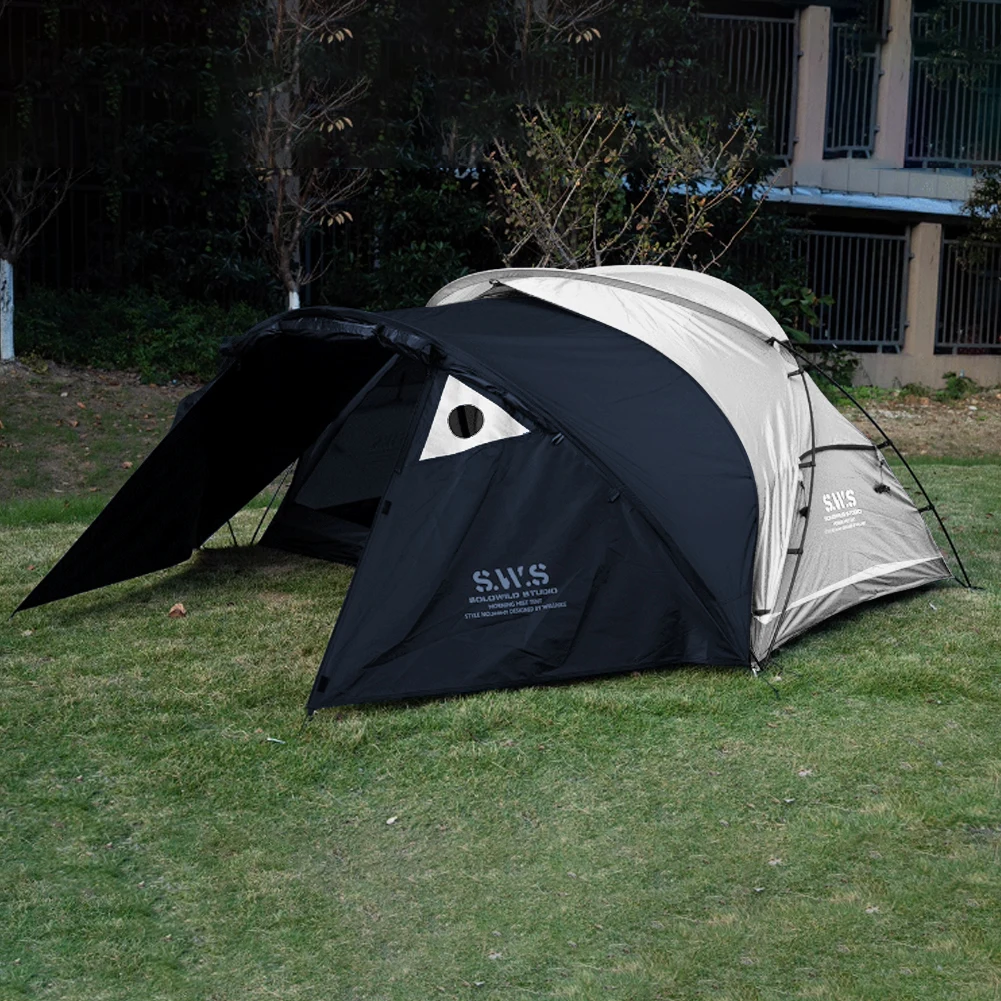
4.3 Weather-Resistant Features
Beyond basic waterproof fabrics, several design elements contribute to a trekking pole tent’s ability to protect you in adverse conditions.
• Bathtub floors: Raised waterproof floors that extend several inches up the sides prevent splash-back and groundwater from entering the tent
• Seam treatment: Quality tents feature taped, bonded or sealed seams to prevent water penetration at stitch lines
• Hydrostatic head ratings: Higher numbers (2000mm+) indicate better waterproofing
• Wind-resistant geometry: Low-profile designs with proper guyout points resist wind better
• Storm doors/panels: Full-coverage doors that can be battened down in severe weather
For comprehensive protection in all conditions, explore our waterproof backpacking tent collection featuring enhanced weather resistance features.
5. Selection Criteria: How to Choose the Right Trekking Pole Tent
With numerous designs and options available, selecting the ideal trekking pole tent requires careful consideration of your specific needs, usage scenarios, and preferences. The following framework will help you navigate the key factors to consider when making this important gear decision.
Understanding how to master two-person lightweight tent setup also plays a critical role in your selection process, as certain designs may better match your comfort with complex pitching procedures.
5.1 Weight vs. Comfort Considerations
Finding your personal balance between minimizing weight and maintaining comfort represents one of the most important decisions in selecting a trekking pole tent.
• Ultralight designs (under 1.5 lbs/680g) often sacrifice interior space, features, and ease of use
• Consider your tolerance for confined spaces, especially during extended weather delays
• Evaluate the psychological comfort of having adequate protected space
• Remember that saving weight at the expense of sleep quality may be counterproductive
• For longer trips, slightly heavier but more comfortable options often prove worthwhile
5.2 Interior Space and Usability
When evaluating interior space, look beyond simple floor dimensions to understand the functional living area the tent provides.
• Sidewall steepness dramatically affects usable space – near-vertical walls maximize livable area
• Head and shoulder room matters more than floor space for comfort during confined periods
• Vestibule size determines protected cooking/gear storage space
• Doorway size and placement impacts ease of entry/exit
• Seated height at key positions (sleeping area, doorway) affects daily living comfort
5.3 Setup Complexity and Site Requirements
Trekking pole tents vary dramatically in their setup requirements and site flexibility, which can significantly impact your camping experience.
• Learning curve: Some designs require significant practice to pitch effectively
• Number of stakes required: More stakes generally means more stability but less site flexibility
• Ground adaptability: Some designs require near-perfect, flat ground
• Non-freestanding nature: All trekking pole tents require some staking, limiting use on rock/platforms
• Setup time: Ranges from under 2 minutes to 10+ minutes depending on design complexity
For detailed instructions on various designs, our guide on how to set up trekking pole tents provides valuable tips.
5.4 Weather Protection Priorities
Different trekking pole tent designs excel in different weather conditions, so prioritize protection based on your expected environment.
• Wind resistance: Pyramid/mid designs typically offer superior wind performance
• Rain protection: Look for adequate vestibule space and protected entrances
• Condensation management: Consider double-wall designs for humid environments
• Snow-loading capacity: Steep-walled pyramids excel for winter camping
• Ventilation options: Critical for managing interior climate in varied conditions
5.5 Your Trekking Pole Compatibility
Not all trekking pole tents work with all trekking poles, making compatibility an important consideration.
• Required pole height: Most designs need poles adjustable to 125-145cm
• Tip style compatibility: Some shelters require specific tip designs
• Strength requirements: Ultralight carbon fiber poles may not provide adequate support
• Fixed-length options: Some shelters accommodate non-adjustable poles
• Alternative support: Consider if the tent can use sticks or separate poles if needed
For more information about finding the right combination, see our guide on compatible trekking poles for tents.
6. Top Trekking Pole Tent Models for Different Hikers
After extensive field testing across diverse environments and conditions, we’ve identified standout trekking pole tent models for different hiking styles, preferences, and budgets. Our recommendations balance weight, livability, weather protection, and value based on real-world performance rather than marketing claims.
6.1 Ultralight Champions (Under 1.5 lbs/680g)
For weight-conscious backpackers where every ounce matters, these ultralight options deliver remarkable protection at minimal weight penalties.
• Featherlight Solo: A 15oz (425g) single-wall shelter using DCF with 18 sq ft floor space and 40” peak height. Its minimalist design offers surprising storm protection with a tiny packed size just larger than a water bottle. Ideal for thru-hikers and ultralight enthusiasts willing to pay premium prices for maximum weight savings.
• AirMid SL: This 19oz (539g) silnylon pyramid shelter offers 25 sq ft of protected space with a 45” center height. Its simple design pitches with just 6 stakes in under 3 minutes, providing excellent wind stability and modest packed size. Perfect for weight-conscious hikers wanting reliable protection without the premium cost of DCF.
• Wisp UL: At just 22oz (624g) this partial double-wall design cleverly combines a mesh inner body with minimal silpoly rainfly, creating excellent condensation management at a surprisingly low weight. With 20 sq ft floor space and 42” height, it balances protection and livability for those prioritizing sleep quality alongside weight savings.
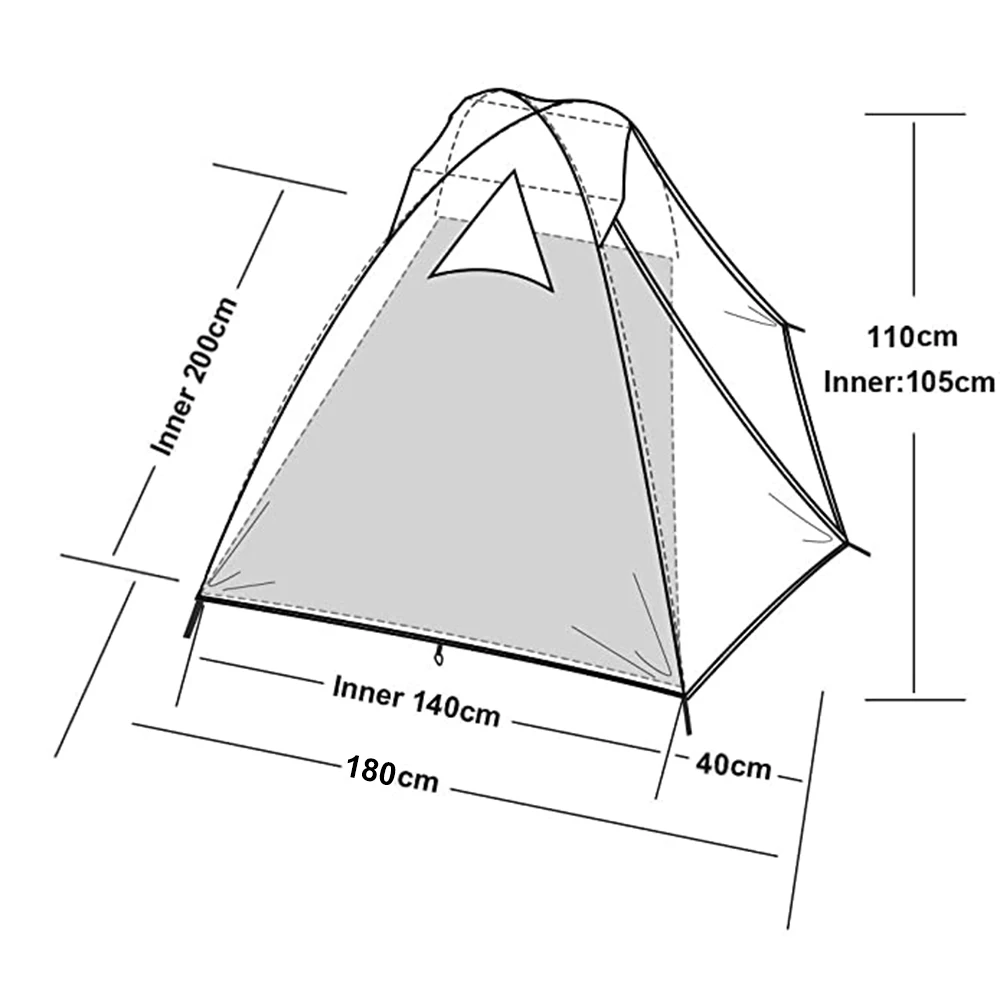
Browse our ultralight backpacking tent collection for more featherweight options.
6.2 Best All-Around Balance (1.5-2.5 lbs/680-1134g)
These models strike an excellent balance between weight savings and comfort, offering practical solutions for most backpackers.
• TrailFort 2P: This 34oz (964g) double-wall design offers a generous 30 sq ft floor with two 8 sq ft vestibules and 45” peak height. Its semi-freestanding nature requires fewer stakes than most trekking pole tents while providing excellent weather protection and ventilation. Ideal for couples or those wanting extra space without excessive weight.
• AlpineShelter Pro: At 28oz (794g) this hybrid single/double-wall design features a breathable solid interior with strategic mesh panels and a waterproof outer layer. Its 28 sq ft floor and steep side walls maximize usable space, while its pyramid-inspired geometry handles wind and snow excellently. Perfect for three-season backpacking with occasional winter use.
• DuoLight SL: This 32oz (907g) true double-wall design prioritizes condensation management and interior comfort with a full mesh inner and separate rainfly. Its rectangular floor plan optimizes the 26 sq ft space for two sleepers, while dual vestibules (6 sq ft each) provide separate storage. Excellent for humid environments and longer trips where comfort matters.
6.3 Most Weather-Resistant Options
When facing challenging conditions, these shelters provide superior protection against wind, rain, and snow.
• StormHaven Mid: This robust 40oz (1134g) silpoly pyramid design features reinforced corners, heavy-duty #8 zippers, and extra guyout points for stability in high winds. Its 30 sq ft floor and 52” peak height create livable space during extended storm delays. The optional clip-in liner adds warmth for winter use while managing condensation.
• AlpineAssault 2: A four-season capable 36oz (1021g) shelter using high-tenacity silnylon with a 3000mm hydrostatic head rating. Its unique supported vestibule design prevents door collapse in heavy snow while maintaining 28 sq ft of protected sleeping space. Strategic ventilation panels reduce condensation even when fully battened down.
• ExpeditionDome: This innovative 42oz (1191g) hybrid design combines trekking pole support with short flexible pole segments to create exceptional stability. Its modified dome geometry sheds wind from all directions while offering 32 sq ft of interior space with a generous 48” height. Perfect for exposed alpine camping and serious weather conditions.
Lightweight Backpacking Tent, Ultralight Backpacking Tent, Ultralight Bivy Tent
Ultralight Single Person Camping Tent with Aluminum Poles for 3-Season Backpacking Waterproof DesignPrice range: $94.88 through $326.82 Select options This product has multiple variants. The options may be chosen on the product pageLightweight Backpacking Tent, Ultralight Backpacking Tent, Waterproof Backpacking Tent
$391.05 Select options This product has multiple variants. The options may be chosen on the product pageCompact Backpacking Tent, Lightweight Backpacking Tent, Waterproof Camping Tent
$335.52 Select options This product has multiple variants. The options may be chosen on the product pageUltralight Backpacking Tent, Ultralight Dome Tent, Winter Camping Tent
Price range: $369.63 through $370.07 Select options This product has multiple variants. The options may be chosen on the product pageBackpacking Tent with Vestibule, Freestanding Backpacking Tent, Lightweight Backpacking Tent
Price range: $446.89 through $447.22 Select options This product has multiple variants. The options may be chosen on the product pageBackpacking Tent with Vestibule, Trekking Pole Backpacking Tent, Waterproof Camping Tent
Price range: $271.99 through $519.52 Select options This product has multiple variants. The options may be chosen on the product page
6.4 Budget-Friendly Recommendations
Quality trekking pole tents don’t necessarily require premium prices – these affordable options deliver solid performance.
• TrailBasic 1P: This straightforward 30oz (850g) A-frame design uses 20D silpoly for a waterproof shelter at a fraction of premium prices. Its 18 sq ft floor and 42” peak height provide adequate space for solo hikers, while the simple 5-stake setup makes it accessible for beginners. At roughly half the price of premium options, it offers excellent value.
• EcoTrek 2: A versatile 36oz (1021g) double-wall design featuring durable 30D silnylon construction at a midrange price point. Its rectangular floor plan maximizes the usable portion of its 28 sq ft interior, while dual vestibules protect gear without sacrificing living space. The perfect entry point for those new to trekking pole tents.
• LightPath Solo: This budget-conscious 28oz (794g) hybrid shelter combines a partial mesh inner with silpoly fly, creating good ventilation at an accessible price. With 20 sq ft floor space and a side-entry design, it offers practical functionality without unnecessary features that drive up costs.
7. Mastering the Perfect Pitch: Setup Tips for Success
The effectiveness of any trekking pole tent depends largely on proper setup. Even the most advanced shelter will underperform if poorly pitched. These techniques will help you achieve a taut, secure setup in various conditions, ensuring maximum protection and comfort.
7.1 Site Selection Fundamentals
Finding the optimal tent site dramatically improves comfort, safety, and shelter performance regardless of the specific tent design you’re using.
• Look for naturally protected areas (tree groves, rock formations) that block prevailing winds
• Select slightly elevated ground that won’t collect water during rain events
• Avoid depressions, dry stream beds, and low spots that can flood rapidly
• Check overhead for dead branches, coconuts, or other “widow makers” that could fall
• Remove sharp objects (sticks, stones) that could damage your tent floor
• Consider sun position – morning sun helps dry condensation, afternoon shade keeps tents cooler
• Follow Leave No Trace principles by using established sites where available and minimizing impact
7.2 Staking and Tensioning Techniques
Proper staking and tensioning are critical for trekking pole tents, directly affecting stability and weather resistance.
• Begin with corner stakes angled outward at 45° for maximum holding power
• Position trekking poles precisely at indicated points, ensuring proper height adjustment
• Apply even tension to all sides, working in opposing pairs
• Use guylines for all provided attachment points in windy conditions
• For soft ground, position stakes horizontally beneath the surface like a dead-man anchor
• In rocky terrain, use rocks to secure guylines when stakes won’t penetrate
• After initial setup, adjust and re-tension the shelter to remove wrinkles and ensure tautness
7.3 Managing Condensation Effectively
Condensation represents one of the biggest challenges with lightweight shelters, but several techniques can minimize moisture buildup.
• Leave vents open whenever possible, even during light precipitation
• Position tent doorways to catch prevailing breezes for improved ventilation
• Avoid camping near water sources when possible to reduce ambient humidity
• Consider site elevation – cold air in valleys traps moisture and increases condensation
• Wipe down interior walls with a bandana in the morning to prevent drips
• Keep wet gear in vestibules rather than inside sleeping area
• For single-wall shelters, maintain several inches of airspace between sleeping bag and tent walls
7.4 Adverse Condition Adaptations
When facing challenging weather, these specialized techniques can enhance your shelter’s performance.
• In high winds, lower your trekking pole height to reduce the shelter’s profile
• Add supplementary guylines to midpoint tie-outs for additional stability
• For snow camping, dig a shallow platform and create snow walls as windbreaks
• During heavy rain, re-tension guylines frequently as fabric may stretch when wet
• In sandy or loose soil, bury stakes horizontally or use stuff sacks filled with sand as anchors
• Consider campsite orientation—position doors away from prevailing winds and rain
• During storms, deploy all possible guylines and tension points, even those that seem redundant
8. Trekking Pole Tents vs. Traditional Designs: A Direct Comparison
Making the transition from conventional tents to trekking pole shelters involves understanding key differences and trade-offs. This comparison helps clarify the advantages and limitations of each approach across important performance criteria.
| Feature | Trekking Pole Tents | Traditional Tents |
|---|---|---|
| Weight | Significantly lighter (25-50% weight savings) | Heavier due to dedicated pole structures |
| Packed Size | Extremely compact, often half the volume | Larger packed size, especially with rigid poles |
| Setup Complexity | Moderate to complex; requires practice | Generally simpler with color-coded poles |
| Site Flexibility | Requires adequate staking ground | More adaptable with freestanding designs |
| Interior Space | Often less headroom except at peak | More uniform headroom throughout |
| Stability | Excellent when properly pitched | Good to excellent depending on design |
| Durability | Typically uses lighter materials | Often uses more robust materials |
| Weather Resistance | Excellent when properly pitched | Good to excellent depending on design |
| Cost | Wide range, with premium options | Wide range, but generally more affordable |
| Learning Curve | Steeper; rewards practice and experience | Gentler; more intuitive setup |
Understanding the differences between freestanding vs. staked hiking shelters helps you determine which system better matches your needs. For most experienced backpackers, trekking pole tents offer compelling advantages once past the initial learning curve – particularly for those prioritizing weight savings and packability over absolute convenience.
9. Creative Alternatives: DIY and Hybrid Setups
Beyond commercial options, the trekking pole tent concept opens up fascinating possibilities for creative customization and do-it-yourself projects. The simplicity of these designs makes them accessible for home fabrication with basic sewing skills.
DIY trekking pole shelters have a rich history in the ultralight community, with several well-established patterns available online. Working with materials like silpoly or silnylon, home sewers can create functional shelters for a fraction of retail prices. Popular starter projects include simple A-frame tarps and flat tarps with catenary edges, which require relatively straight seams and basic construction techniques.
For those not ready to build from scratch, several creative adaptations can apply trekking pole concepts to traditional tents:
• Replace broken tent poles with trekking poles using adapter sleeves
• Add trekking pole supports to standard tarps for improved headroom
• Create hybrid setups connecting a tarp to a bivy or bug net shelter
• Use trekking poles to reinforce existing freestanding tents in high winds
Online communities dedicated to ultralight backpacking offer extensive resources, templates, and material sources for those interested in exploring the DIY route. The modular nature of these systems encourages experimentation and customization to match your specific needs and environmental conditions.
10. FAQ: Common Questions About Trekking Pole Tents
Can trekking pole tents withstand strong winds and storms?
Yes, many trekking pole tent designs actually excel in windy conditions when properly pitched. Their low profiles and aerodynamic shapes – particularly pyramid designs – can outperform many freestanding tents in high winds. The key is proper site selection, complete staking, and using all guyline attachments. A well-pitched pyramid or mid-style shelter can remain stable in winds exceeding 40 mph (64 km/h).
How do trekking pole tents perform in winter conditions?
Many trekking pole tents perform excellently in winter, especially pyramid and mid designs. Their steep walls shed snow effectively, and their adjustable height allows you to pitch them lower in severe conditions. Models with solid inner walls (rather than mesh) provide better insulation. The main consideration is having sufficient interior space for extended periods inside and adequate ventilation to manage condensation from cooking and breathing in cold conditions.
What if one of my trekking poles breaks during a trip?
This is a legitimate concern with simple solutions. Most trekking pole tents can be pitched using found sticks of appropriate length as substitutes. Many hikers carry a small repair sleeve that can temporarily fix a broken pole section. Some designs can also be modified to use a single pole in emergency situations with additional guylines. Finally, hanging the tent apex from a tree branch offers another alternative in forested areas.
Are trekking pole tents suitable for beginners?
While they typically have a steeper learning curve than freestanding tents, many beginners successfully use trekking pole tents after practicing setup at home. Start with simpler designs like basic A-frames or pyramids, and practice in your backyard before heading out. Understanding site selection becomes more important, but the significant weight savings can be especially beneficial for beginners still developing their hiking fitness.
Do I need special trekking poles for these tents?
Most trekking pole tents work with standard adjustable hiking poles, but there are some considerations. Ensure your poles extend to the required height (typically 125-145cm) and have durable tips compatible with your tent’s pole attachment system. Flip-lock adjustment mechanisms generally provide more reliable tension than twist-locks when supporting a shelter. Very lightweight carbon fiber poles may not provide adequate stiffness for larger shelters in windy conditions.
11. Is a Trekking Pole Tent Right for Your Next Adventure?
After exploring the world of trekking pole tents, you may be wondering if these innovative shelters align with your personal outdoor needs. The decision ultimately depends on your specific hiking style, priorities, and comfort preferences.
For weight-conscious backpackers covering substantial distances, trekking pole tents offer compelling advantages that directly enhance the hiking experience. The weight and space savings create a more comfortable carrying experience, potentially allowing you to hike farther with less fatigue or carry additional comforts elsewhere in your pack. The multi-functionality of using your trekking poles for both hiking support and shelter structure exemplifies the efficient approach that experienced backpackers develop over time.
For weekend backpackers making shorter trips or those who prioritize setup convenience above all else, the learning curve and site selection requirements of trekking pole tents might outweigh their benefits. Similarly, car campers who don’t carry their shelter long distances might find traditional freestanding tents more suitable for their needs. Understanding the advantages of trekking pole supported shelters helps clarify if these benefits align with your priorities.
The future of lightweight shelter design continues to evolve toward these efficient, multi-functional systems. As materials improve and designs become increasingly refined, we expect even better options to emerge. While traditional freestanding tents will always have their place, the trekking pole shelter concept represents a thoughtful evolution in backpacking gear philosophy – doing more with less, without sacrificing protection when it matters most.

